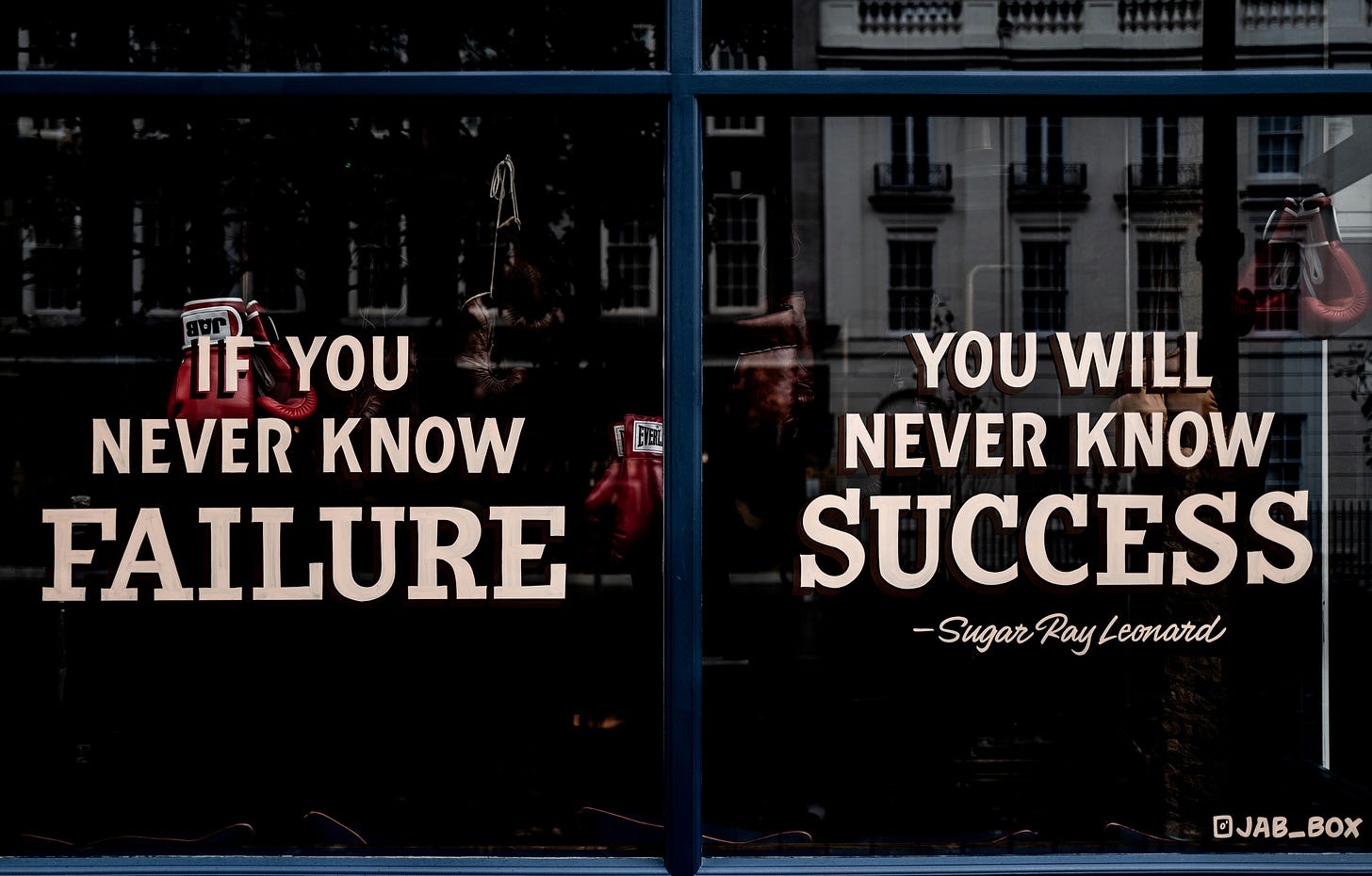“Some failures sting. Some scar. Some set us free. The work is in knowing which is which.”
- Nabeela Elsayed
I was recently coaching someone who struggled with communicating upward. They expressed to me that when it came to leading and managing their team, they had confidence, they could connect, they could motivate- but when they were put in a room with someone more senior, they froze.
The individual went on to share that their confidence was significantly different when dealing with someone more senior than them. The questions I asked them revolved around their ideas about success, failure, and judgment. As we unpacked it, the sense of fear they were describing was very familiar to the type of fear someone may experience before stepping on stage, or the fear of public speaking or giving a presentation. It is a fear rooted in judgment, a fear rooted in the idea that instead of applause, we will meet an audience that is going to throw eggs and rotten tomatoes at us. It is the fear of judgment, fear of seeming incompetent, the fear of failing in front of someone who wields significant influence and power.
But what if we took that power back?
What if we could wrestle down the fear?
And what do we need to do to reframe fear?
Lots of organizations talk about creating cultures where people can fail and learn fast, but few organizations actually nurture a culture where failure can happen without shame or consequences.
While I was at IKEA, we wanted to nurture such a culture and in order to do so, we had to start by de-stigmatizing failure and positioning it in a new light. To do that, we launched a program called Failure Friday. It was simple: leaders were invited to share their most epic failures without the spin or polish. Just honest stories of missteps, stumbles, and things that didn’t go as planned. The goal was to take the fear out of failure, or at least loosen its grip.
Because the fear of failure is often what holds our ambition, our creativity, our dreams, and our fulfillment hostage.
Failure as the Opposite of Success?
If you ask Google to define failure, you’ll get something like “lack of success.” The synonyms? “Non-success,” “defeat,” “losing.” The fear of failure is defined as the propensity to experience shame in response to failure, and it has long been studied for its psychological and behavioral impacts. This type of fear often leads individuals to adopt avoidance-based goals, which result in lower effort, diminished persistence, poorer performance, and ultimately, lower life satisfaction.
So failure is the lack of “success,” and fear of failure happens when we associate shame with failure. Our belief systems about success cannot be rewired without unlearning the myths around failure. How we handle failure—both as individuals and as leaders—is rooted in the shame associated with failing.
So the steps here are simple in theory: first, we need to move from a binary approach to success and failure and instead see them as intertwined characteristics. Second, we need to remove the shame associated with failure.
Most successes are built on a trail of failed experiments, wrong turns, and lessons that only come through trial and error. Failure isn’t the opposite of success—it’s part of it, and often, it’s success’s prerequisite.
An Alternative Failure Framework
Amy Edmondson, a Harvard professor and leading voice on failure in organizations, talks about failure on a continuum that is really helpful. In her Harvard Business Review article on failure, she outlines three categories of failure:
1. Preventable failures in predictable operations
2. Complexity-related failures in unpredictable systems
3. Intelligent failures at the frontier of experimentation
Most people are raised to believe all failure is bad, hence the association with shame. And then we enter workforces where we echo this belief by treating failures as blameworthy, reinforcing the fear of failure as something shameful. In fact, when Edmondson asked leaders how many failures are actually blameworthy, they usually say 2–5%. But when they are asked how many failures are treated as blameworthy? The answer jumps to 70–90%.
To change our thinking, we need to believe that failure lives on a spectrum. There is failure that is neutral, think about a child who is still learning and spills their milk. It just is. It’s a byproduct of their growth and development. No need to make it a lesson or assign blame. You might just move on, downplay it, clean up the spill with a smile.
Then there is failure that is clearly blameworthy think about driving under the influence or texting while driving. These failures are negligent, not only putting your own life at risk but the lives of others as well. Less dramatic, perhaps, are low-quality failures: the preventable kind. When the playbook is clear, the processes are well-established, but something still falls apart. These are execution errors. Think: missing a critical step, ignoring the checklist, or dropping the ball out of neglect. The learning here is important, but often limited.
And here is where most people stop when we think about failure. But we shouldn’t. We also need to think of failures as praiseworthy.
Praiseworthy failures are high-quality failures. Edmondson argues that failures can be praiseworthy when they are the product of “thoughtful experimentation that generates valuable information.”
High-quality, praiseworthy failures happen when you take a leap into the unknown. You test a bold hypothesis, you design a new way of working, or you try something that’s never been done before. The chance of failure is high, but the learnings are worth it because it expands your understanding. These are the kinds of failures that Edmondson says should be celebrated, not shamed.
Reframe #1- Not all failures are created equal. Some are reckless. Some are avoidable. But others? They’re the prize of playing at the edge of possibility.
Reframe #2- We need to think about failures as neutral, blameworthy, and praiseworthy.
I also want to note that not all failure’s have to be a lesson- so you can put your agile retrospective notion template away. Some failures just plane suck and in those cases people don’t need a trite quotes or toxic productivity what they need is the ability to handle the failure as a grieving process because failure involves real grief.
Grieving the Hard Ones
Some failures hurt because they cost us time, money, confidence, relationships and our health. They leave a dent. And in those moments, most people don’t need someone telling them that there is a lesson in the failure, they don’t need a pep talk that one door closes and another door opens. What they need is space. People need the permission to grieve.
Entrepreneur Steve Blank, the co-founder of the lean startup movements outlines what he calls the six stages of failure and his steps closely mirror the grief process:
1. Shock and surprise
2. Denial
3. Anger and blame
4. Depression
5. Acceptance
6. Insight and change
Failure is emotional. It should be, to think that it wont be is naive. But if we let ourselves process it fully, we can move through the pain and into wisdom.
Reframe #3 is when failure hits hard, let yourself do the grieving process before you try to garner any life lessons.
Why Failure Hits Harder for Women
The last note I want to make on the topic of failure is that gender differences exist on haw failure is viewed and handled. Women often internalize failure and blame a failure on them, where men will often blame a failure on some type of external factor around them.
Girls and women consistently report higher levels of fear of failure than boys and men. Traditionally, these differences were explained through the lens of sex role socialization which is the idea that girls are socialized to be compliant, risk-averse, and perfectionistic.
However, a more recent and striking finding described as the gender-equality paradox reveals that this gender gap in fear of failure is more pronounced in countries with higher levels of gender equality. What that means is that in societies where girls have more formal opportunities, they also tend to report higher levels of internalized fear of failure compared to boys.
The researchers suggest that this paradox may be explained by the dual burden faced by girls in gender-equal societies: while they gain access to expanded educational and career opportunities, they are also met with heightened societal expectations to succeed in both traditionally feminine and masculine domains. In essence the shame of not being able to handle it all increases the fear of failure. This creates a psychological bind: girls may feel less able to attribute failure to external systems, are therefore more likely to blame themselves, increasing the emotional cost of failure and deepening their fear of failure, shaping how girls approach risk, leadership, and identity formation over time.
Turn Your Failure Hall of Shame into a Failure Hall of Fame
Now that we have reframed failure, it’s your turn. This is a simple exercise to deepen your own insights. Here’s how to do the exercise:
Sit down with yourself and ask yourself to list out your EPIC failures. Once you have written them all down, use Steve Blank’s six steps to ask yourself: how do you feel about that failure? Go through the list one by one and ask yourself - does the failure evoke shame, anger, or blame? Or does it bring about insight and has it led to meaningful change?
Depending on how you feel about that failure you may need to sit with it. If it evokes shame, anger, or blame let yourself go through the process to come to peace with it.
Once you have processed the failure, you can then evaluate the insights or changes that have come as a result of it.
Then I want you to literally type or write out the failure and print it out yes, I know, pretty old school but trust me, this step is important. Print it out, frame the failure, and stick it on your wall. Create a literal Failure Hall of Fame.
Put it somewhere where you can look at the failure regularly until you can confidently celebrate the failure. Openly talk about the failure with people who ask. Find the beauty in it. Take back the power. Tackle the fear of failure down staring it straight in the face.
It is only when we reframe our fear of failure and build the ability to celebrate it that we will stop allowing the fear of failure to overpower us.
You don’t need to fear your failures. You don’t need to hide them. In fact, the more you face them, grieve them properly, honor them the more remarkable you become. Not in spite of them, but because of them. Let your Failure Hall of Fame be a mirror not of your flaws, but of your budding fearlessness.
As always, take care of yourself and those around you.
In partnership,
Nabeela
Like, Share & Comment!
If you found this post helpful and feel so inclined, please hit the ❤️ button at the top or bottom of this email to help others discover Re-Imagine Success.
And.. don’t be shy! Please let me know your thoughts by commenting.
Your support means a lot!
If you would like to learn more about the world's unhealthy relationship with work, success, and achievement and discover ways to escape the burnout loop, check out some of my other posts below:

















Share this post